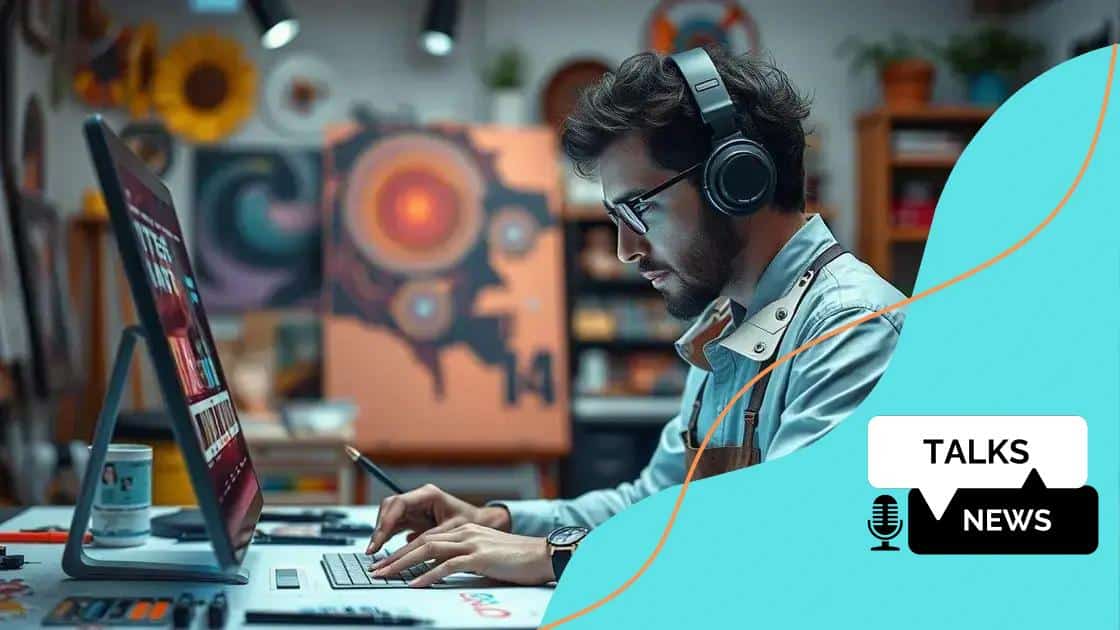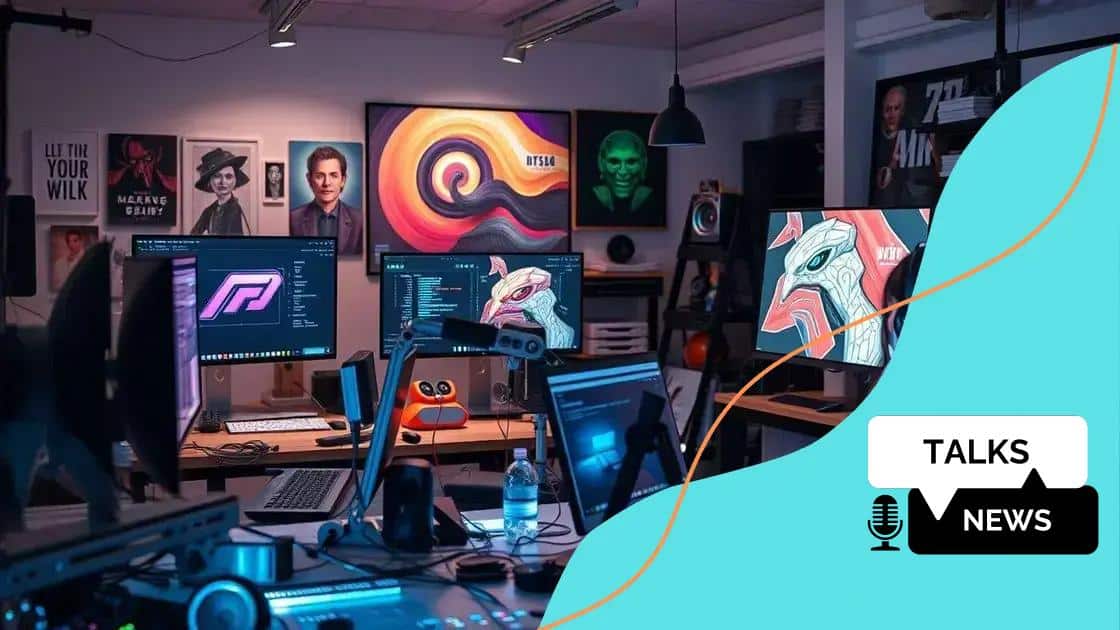The role of AI in transforming the creative industries

The role of AI in transforming the creative industries enables artists and designers to enhance their creative processes, tackle challenges like job displacement, and engage audiences through interactive experiences.
The role of AI in transforming the creative industries is a fascinating topic that invites curiosity. Imagine how artists and creators are leveraging technology to enhance their work and reach new audiences. Let’s explore these exciting developments together.
How AI is influencing artistic expression
The influence of AI on artistic expression is profound and multi-faceted. It opens new doors for artists, allowing them to explore uncharted territories of creativity. Artists are now incorporating AI tools into their workflows, enriching their work while also challenging traditional notions of authorship.
AI as a Creative Partner
Many artists are using AI to generate ideas, assist in the creation process, and even collaborate on art pieces. This partnership between human creativity and machine intelligence results in innovative art forms that blend the best of both worlds.
Utilizing AI can:
- Enhance the creative process by providing novel visual suggestions.
- Automate repetitive tasks which allows artists to focus on more important aspects.
- Broaden the scope of what can be considered art.
AI is not just a tool; it transforms how we view creativity. It raises questions about the essence of art and the role of the artist. As machines start generating their own creative expressions, the line between human and machine-made art blurs. This shift encourages artists to rethink their methodologies.
The Emergence of AI Art
AI-generated art is gaining popularity and recognition. Many galleries and museums now showcase works created with the help of AI algorithms. This shift signifies a new era in the art world, where technology significantly shapes the creative landscape.
Some notable aspects of AI-generated art include:
- Unique styles and techniques that are not possible for human artists alone.
- The ability to analyze large data sets to create art that reflects diverse influences.
- Engagement with new audiences who appreciate the blend of technology and creativity.
As this trend continues, more artists will likely embrace AI as part of their creative toolkit. The conversation around AI will also grow, with discussions focusing on ethics, creativity, and what it means to be an artist in the age of technology.
Ultimately, AI’s role in influencing artistic expression isn’t just about technology; it’s about expanding the possibilities of creativity itself. As we move forward, we can expect to see even more exciting developments in this ever-evolving relationship between art and AI.
The impact of AI on music and film production
The impact of AI on music and film production is reshaping how creators approach their craft. It introduces new tools that can enhance creativity while streamlining the production process.
Transforming Music Creation
In music, AI is used to analyze trends and generate compositions. Artists can now collaborate with AI to produce unique sounds and styles that push the boundaries of traditional music.
Some significant ways AI is impacting music include:
- Automating sound mixing, which saves time and reduces costs.
- Creating personalized playlists to enhance listener experience.
- Generating original melodies and lyrics.
This blend of human creativity and AI technology allows artists to experiment with new genres and styles that were once unimaginable. By utilizing AI, musicians can reach broader audiences and engage listeners on a deeper level.
Revolutionizing Film Production
Similarly, in the film industry, AI is being integrated into various stages of production. From scriptwriting to editing, AI tools help filmmakers optimize their workflow and achieve their creative vision more efficiently.
A few notable applications of AI in film include:
- Automated editing processes, reducing the time taken to finalize a project.
- AI-generated storyboarding that visualizes scripts before filming.
- Enhanced visual effects through advanced algorithms.
This evolution in the film industry not only speeds up production but also elevates the quality of the films being produced. Filmmakers can now focus more on storytelling and artistic direction instead of getting bogged down in technical details.
As AI continues to evolve, we can expect even more innovations in music and film. The relationship between technology and creativity will only deepen, leading to products that challenge our perceptions of art. Artists, musicians, and filmmakers are learning to harness the power of AI, resulting in a new era of creative expression.
AI tools shaping graphic design and visual arts

AI tools are shaping graphic design and visual arts in innovative ways. These technologies enable artists to enhance their creative processes, allowing for unique forms of expression that were once thought impossible.
Enhancing Creativity with AI
Graphic designers now use AI to generate ideas and improve their workflows. By analyzing vast amounts of data and trends, AI can suggest designs that appeal to specific audiences.
Key impacts of AI in graphic design include:
- Automated image editing that saves time and effort.
- AI-driven design software that helps create logos or marketing materials.
- Advanced algorithms that generate unique color palettes and layouts.
With AI, designers can experiment with new styles and techniques, enhancing their creative output. This partnership between man and machine leads to innovative artwork that challenges traditional boundaries.
Transforming Visual Arts
In the realm of visual arts, AI tools are being employed to create striking pieces that captivate audiences. These technologies assist artists in exploring new dimensions of creativity.
For instance, AI can:
- Analyze existing artworks to inspire new creations.
- Generate art based on specific themes, styles, or emotions.
- Facilitate interactive installations that engage viewers in unique ways.
As a result, artists are finding fresh ways to communicate their ideas, using technology as an ally rather than a rival. This shift represents a new era in which art is more accessible and diverse.
Moreover, the collaboration between AI and artists is fostering exciting discussions about the nature of creativity and authorship. As tools improve, the possibilities for expression expand, paving the way for a vibrant future in graphic design and visual arts.
Challenges faced by creatives in the AI era
Creative professionals face several challenges in the AI era. As artificial intelligence continues to evolve, it brings both opportunities and obstacles to artists, designers, and musicians. The balance between using AI to enhance creativity and maintaining authenticity can be difficult to navigate.
AI and Job Displacement
One of the most significant concerns is job displacement. As AI tools become more capable of performing creative tasks, many fear they might replace human roles in creative industries. This shift raises questions about job security and the future of work.
Key points to consider include:
- Automation of routine tasks, which can lead to fewer job openings.
- The potential reduction in demand for traditional creative roles.
- Fear among creatives about being undervalued as machines take on more complex tasks.
While AI can make creative processes more efficient, it can also create uncertainty in job markets. Artists must adapt by developing new skills that complement AI technologies.
Maintaining Artistic Integrity
Another challenge is maintaining artistic integrity. As creatives incorporate AI into their work, concerns arise about originality and authenticity. The line blurs between human-made and machine-generated art, leading to debates over authorship.
Creatives often struggle with:
- Ensuring their unique voice is not lost in AI-generated content.
- Dealing with audiences’ perceptions of AI-created work.
- Defining what it means to be a “real” artist in the age of technology.
These issues force artists to reconsider how they approach their craft and how much they rely on AI. It prompts a deeper exploration of their creative processes and the value of human touch.
Moreover, adapting to new tools and changing industry dynamics can be overwhelming. Creatives must find ways to leverage AI while still expressing their unique visions and styles.
The future of creativity with AI integration
The future of creativity with AI integration looks promising and filled with endless possibilities. As artificial intelligence continues to advance, it opens up new pathways for artists, musicians, and designers to express their ideas.
Expanding Creative Horizons
AI tools are set to enhance creativity by offering new ways of thinking about art. These technologies can analyze trends, suggest improvements, and even create art that pushes current boundaries.
Some benefits of AI in creativity include:
- Assisting artists in developing unique styles by generating new ideas.
- Enabling musicians to compose music that blends various genres effortlessly.
- Providing designers with innovative tools for creating stunning visuals quickly.
This collaboration between human creativity and AI technology encourages artists to experiment and innovate. The fusion of these elements leads to more engaging and diverse artistic expressions.
Collaboration and Interactivity
The integration of AI fosters collaboration among creators and their audiences. AI can help personalize experiences, allowing viewers to engage with art in more interactive ways.
Key aspects of this shift involve:
- Creating interactive installations that respond to audience input.
- Developing virtual reality experiences driven by AI analytics.
- Enabling real-time feedback that influences artistic direction.
As artists leverage AI, the nature of creativity becomes more democratic. Anyone can become a creator, using these tools to express themselves and share their vision with the world.
Furthermore, educational platforms are now incorporating AI to teach artistic skills, making creative learning more accessible to everyone. This evolution signifies that the future will be shaped not only by technology but by the collective aspirations of all creators.
FAQ – Questions about AI in the Creative Industries
How is AI changing the way artists create?
AI offers new tools and techniques that enable artists to explore different styles and enhance their creative process.
What challenges do creatives face with AI integration?
Challenges include job displacement, maintaining artistic integrity, and navigating the balance between human creativity and machine-generated art.
Can AI improve audience engagement with art?
Yes, AI can create interactive experiences that make art more engaging and personalized for audiences.
What does the future hold for creativity with AI?
The future looks bright as AI continues to evolve, empowering artists and expanding possibilities for creativity in various fields.





